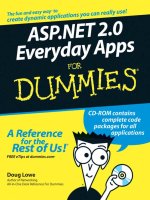ASP.NET 2.0 Everyday Apps For Dumies 2006 phần 6 docx
Bạn đang xem bản rút gọn của tài liệu. Xem và tải ngay bản đầy đủ của tài liệu tại đây (1.07 MB, 43 trang )
Listing 6-13
(continued)
return _state;
}
set
{
_state = value;
}
}
public string ZipCode
➝
9
{
get
{
return _zipCode;
}
set
{
_zipCode = value;
}
}
public string Email
➝
10
{
get
{
return _email;
}
set
{
_email = value;
}
}
public string PhoneNumber
➝
11
{
get
{
return _phoneNumber;
}
set
{
_phoneNumber = value;
}
}
}
The following paragraphs define each component of this class:
➝
1 The class begins by defining private instance variables that are
used to hold the values associated with the class properties.
By convention, each of these variable names begins with an
196
Part III: Building E-Commerce Applications
12_597760 ch06.qxp 1/11/06 9:56 PM Page 196
underscore to indicate that it corresponds to a property with the
same name.
➝
2 The default constructor creates a Customer object with default
values for each of its properties.
➝
3 This constructor accepts arguments that initialize the customer
data. Notice that the assignment statements don’t directly assign
values to the instance variables of the class. Instead, they use the
properties to assign these values. That way, any validation rou-
tines written in the property setters will be used. (In this example,
none of the property setters have validation routines. Still, it’s a
good practice to follow just in case.)
➝
4 The LastName property represents the customer’s last name. Its
get routine simply returns the value of the _lastName instance
variable, and its set routine simply sets the _lastName variable
to the value passed via the value argument.
➝
5 The FirstName property represents the customer’s first name,
which is stored in the _firstName instance variable.
➝
6 The Address property represents the customer’s address, stored
in the _address instance variable.
➝
7 The City property represents the customer’s city, stored in the
_city instance variable.
➝
8 The State property represents the customer’s state, stored in the
_state instance variable.
➝
9 The ZipCode property represents the customer’s Zip code, stored
in the _zipCode instance variable.
➝
10 The Email property represents the customer’s e-mail address,
stored in the _email instance variable.
➝
11 The PhoneNumber property represents the customer’s phone
number, stored in the _phoneNumber instance variable.
Listing 6-14: The Customer class (VB version)
Imports Microsoft.VisualBasic
Public Class Customer
Private _lastName As String
➝
1
Private _firstName As String
Private _address As String
Private _city As String
Private _state As String
Private _zipCode As String
Private _phoneNumber As String
(continued)
197
Chapter 6: Building a Shopping Cart Application
12_597760 ch06.qxp 1/11/06 9:56 PM Page 197
Listing 6-14
(continued)
Private _email As String
Public Sub New()
➝
2
End Sub
Public Sub New(ByVal lastName As String, _
➝
3
ByVal firstName As String, _
ByVal address As String, _
ByVal city As String, _
ByVal state As String, _
ByVal zipCode As String, _
ByVal phoneNumber As String, _
ByVal email As String)
Me.LastName = lastName
Me.FirstName = firstName
Me.Address = address
Me.City = city
Me.State = state
Me.ZipCode = zipCode
Me.PhoneNumber = phoneNumber
Me.Email = email
End Sub
Public Property LastName() As String
➝
4
Get
Return _lastName
End Get
Set(ByVal value As String)
_lastName = value
End Set
End Property
Public Property FirstName() As String
➝
5
Get
Return _firstName
End Get
Set(ByVal value As String)
_firstName = value
End Set
End Property
Public Property Address() As String
➝
6
Get
Return _address
End Get
Set(ByVal value As String)
_address = value
End Set
End Property
Public Property City() As String
➝
7
Get
198
Part III: Building E-Commerce Applications
12_597760 ch06.qxp 1/11/06 9:56 PM Page 198
Return _city
End Get
Set(ByVal value As String)
_city = value
End Set
End Property
Public Property State() As String
➝
8
Get
Return _state
End Get
Set(ByVal value As String)
_state = value
End Set
End Property
Public Property ZipCode() As String
➝
9
Get
Return _zipCode
End Get
Set(ByVal value As String)
_zipCode = value
End Set
End Property
Public Property Email() As String
➝
10
Get
Return _email
End Get
Set(ByVal value As String)
_email = value
End Set
End Property
Public Property PhoneNumber() As String
➝
11
Get
Return _phoneNumber
End Get
Set(ByVal value As String)
_phoneNumber = value
End Set
End Property
End Class
Creating the ShoppingCart Class
The ShoppingCart class represents the user’s virtual shopping cart, as
described in detail earlier in this chapter (see Table 6-5). Now, Listing 6-15
presents the C# version of the ShoppingCart class, and the Visual Basic ver-
sion is shown in Listing 6-16.
199
Chapter 6: Building a Shopping Cart Application
12_597760 ch06.qxp 1/11/06 9:56 PM Page 199
Listing 6-15: The ShoppingCart class (C# version)
using System;
using System.Data;
using System.Configuration;
using System.Web;
using System.Web.Security;
using System.Web.UI;
using System.Web.UI.WebControls;
using System.Web.UI.WebControls.WebParts;
using System.Web.UI.HtmlControls;
using System.Collections.Generic;
public class ShoppingCart
{
private List<CartItem> _cart;
➝
1
public ShoppingCart()
➝
2
{
_cart = new List<CartItem>();
}
public List<CartItem> GetItems()
➝
3
{
return _cart;
}
public void AddItem(string id, string name,
➝
4
decimal price)
{
bool itemFound = false;
foreach (CartItem item in _cart)
{
if (item.ID == id)
{
item.Quantity += 1;
itemFound = true;
}
}
if (!itemFound)
{
CartItem item =
new CartItem(id, name, price, 1);
_cart.Add(item);
}
}
public void UpdateQuantity(int index,
➝
5
int quantity)
{
CartItem item = _cart[index];
item.Quantity = quantity;
200
Part III: Building E-Commerce Applications
12_597760 ch06.qxp 1/11/06 9:56 PM Page 200
}
public void DeleteItem(int index)
➝
6
{
_cart.RemoveAt(index);
}
public int Count
➝
7
{
get
{
return _cart.Count;
}
}
}
The following paragraphs describe the important details of this class:
➝
1 A private instance variable named _cart holds the contents of
the shopping cart. This variable uses the new Generics feature to
create a list object that can only hold objects of type CartItem.
(For more information about generics, see the sidebar “Using
Generics” later in this section.)
To use the List class, you must provide an imports (C#) or
Using (VB) statement that specifies the namespace System.
Collections.Generic.
➝
2 The constructor for this class creates an instance of the List
class and assigns it to the _cart variable.
➝
3 The GetItems method returns a List that contains CartItem
objects. It simply returns the _cart variable.
➝
4 The AddItem method adds an item to the shopping cart, using the
product ID, name, and price values passed as parameters. It uses a
for each loop to search the items in the cart. If one of the items
already in the cart has a product ID that matches the ID passed as
a parameter, that item’s quantity is incremented and a local vari-
able named itemFound is set to true. If a matching item is not
found by the for each loop, a new CartItem object is created
with a quantity of 1. Then the new cart item is added to the list.
➝
5 The UpdateQuantity method changes the quantity for a speci-
fied product. It uses the index value passed as a parameter to
access the cart item, then sets the item’s Quantity property to
the value passed via the quantity parameter.
➝
6 The DeleteItem method uses the RemoveAt method of the List
class to remove the item at the index passed via the parameter.
➝
7 The Count property simply returns the Count property of the
_cart list. Notice that since this is a read-only property, no set
routine is provided.
201
Chapter 6: Building a Shopping Cart Application
12_597760 ch06.qxp 1/11/06 9:56 PM Page 201
Listing 6-16: The ShoppingCart class (VB version)
Imports Microsoft.VisualBasic
Imports System.Collections.Generic
Public Class ShoppingCart
Private _cart As List(Of CartItem)
➝
1
Public Sub New()
➝
2
_cart = New List(Of CartItem)()
End Sub
Public Function GetItems() As List(Of CartItem)
➝
3
Return _cart
End Function
Public Sub AddItem(ByVal id As String, _
➝
4
ByVal name As String, _
ByVal price As Decimal)
Dim itemFound As Boolean = False
For Each item As CartItem In _cart
If item.ID = id Then
item.Quantity += 1
itemFound = True
End If
Next
If Not itemFound Then
Dim item As CartItem
item = New CartItem(id, name, price, 1)
cart.Add(item)
End If
End Sub
Public Sub UpdateQuantity( _
➝
5
ByVal index As Integer,
ByVal quantity As Integer)
Dim item As CartItem
item = _cart(index)
item.Quantity = quantity
End Sub
Public Sub DeleteItem(ByVal index As Integer)
➝
6
_cart.RemoveAt(index)
End Sub
Public ReadOnly Property Count() As Integer
➝
7
Get
Return _cart.Count
End Get
End Property
End Class
202
Part III: Building E-Commerce Applications
12_597760 ch06.qxp 1/11/06 9:56 PM Page 202
Creating the CartItem Class
The CartItem class defines an item in the user’s shopping cart. The
ShoppingCart class itself (presented in the previous section) is basically a
list of CartItem objects. For a list of properties provided by the CartItem
class, refer to Table 6-6. Listings 6-17 and 6-18 present the C# and Visual Basic
versions of this class.
203
Chapter 6: Building a Shopping Cart Application
Using Generics
Generics
is a new feature of both the C# and the
Visual Basic programming languages. The pur-
pose of the Generics feature is to prevent a
common problem when dealing with .NET col-
lection classes. Suppose you want to store a
collection of Customer objects. You can do
that by declaring an ArrayList object, then
adding Customer objects to the array list.
However, nothing prevents you from adding
other types of objects to the array list. If you
were careless, you could also add a
ShoppingCart object to the array list.
With the new Generics feature, you can create
collections that are designed to hold only objects
of a specified type. For example, you can create
a list that can hold only Customer objects.
Then, if you try to add a ShoppingCart object
to the list by accident, an exception will be
thrown.
Along with the Generics feature comes a
new namespace (System.Collections.
Generic) with a set of collection classes that
are designed to work with the Generics feature.
Here are the classes you’ll probably use most:
ߜ List: A generic array list.
ߜ SortedList: A generic list that’s kept in sorted
order.
ߜ LinkedList: A generic linked list.
ߜ Stack: A generic last-in, first-out stack.
ߜ Queue: A generic first-in, first-out queue.
ߜ Dictionary: A generic collection of key/value
pairs.
ߜ SortedDictionary: A generic collection of
key/value pairs kept in sorted order.
The syntax for using the Generics feature takes
a little getting used to. Here’s a C# example that
defines a variable of type List whose objects
are Customer types, then creates an instance
of the list and assigns it to the variable:
List<Customer> custlist;
custlist = new
List<Customer>();
Notice how the generic type is enclosed in
greater-than and less-than symbols.
Here’s the same example in Visual Basic:
Dim custlist As List(Of
Customer)
custlist = New List(Of
Customer)()
As you can see, Visual Basic uses the Of key-
word to indicate the generic type.
12_597760 ch06.qxp 1/11/06 9:56 PM Page 203
Listing 6-17: The CartItem class (C# version)
using System;
using System.Data;
using System.Configuration;
using System.Web;
using System.Web.Security;
using System.Web.UI;
using System.Web.UI.WebControls;
using System.Web.UI.WebControls.WebParts;
using System.Web.UI.HtmlControls;
public class CartItem
{
private string _id;
➝
1
private string _name;
private decimal _price;
private int _quantity;
public CartItem()
➝
2
{
this.ID = “”;
this.Name = “”;
this.Price = 0.0m;
this.Quantity = 0;
}
public CartItem(string id, string name,
➝
3
decimal price, int quantity)
{
this.ID = id;
this.Name = name;
this.Price = price;
this.Quantity = quantity;
}
public string ID
➝
4
{
get
{
return _id;
}
set
{
_id = value;
}
}
public string Name
➝
5
{
get
{
return _name;
204
Part III: Building E-Commerce Applications
12_597760 ch06.qxp 1/11/06 9:56 PM Page 204
}
set
{
_name = value;
}
}
public decimal Price
➝
6
{
get
{
return _price;
}
set
{
_price = value;
}
}
public int Quantity
➝
7
{
get
{
return _quantity;
}
set
{
_quantity = value;
}
}
public decimal Total
➝
8
{
get
{
return _price * _quantity;
}
}
}
Here are the key points to take note of in these listings:
➝
1 The private instance variables _id, _name, _price, and
_quantity hold the values for the cart item’s properties.
➝
2 The first constructor, which has no parameters, simply initializes
the class properties to default values.
➝
3 The second constructor lets you create a CartItem object and set
the ID, Name, Price, and Quantity properties at the same time.
➝
4 The ID property provides the ID of the product referred to by the
cart item. It uses the private instance variable id to store its value.
205
Chapter 6: Building a Shopping Cart Application
12_597760 ch06.qxp 1/11/06 9:56 PM Page 205
➝
5 The Name property represents the name of the product referred to
by the cart item. It uses the private instance variable name.
➝
6 The Price property represents the price of the product. It uses
the _price variable to store its value.
➝
7 The Quantity property records the quantity for the cart item. It
stores its value in the _quantity variable.
➝
8 The Total property returns the value Price property multiplied
by the Quantity property. Notice that this property’s value isn’t
stored in an instance variable. Instead, the value is recalculated
each time it is accessed.
Listing 6-18: The CartItem class (VB version)
Imports Microsoft.VisualBasic
Public Class CartItem
Private _id As String
➝
1
Private _name As String
Private _price As Decimal
Private _quantity As Integer
Public Sub New()
➝
2
Me.ID = “”
Me.Name = “”
Me.Price = 0.0
Me.Quantity = 0
End Sub
Public Sub New(ByVal id As String, _
➝
3
ByVal name As String, _
ByVal price As Decimal, _
ByVal quantity As Integer)
Me.ID = id
Me.Name = name
Me.Price = price
Me.Quantity = quantity
End Sub
Public Property ID() As String
➝
4
Get
Return _id
End Get
Set(ByVal value As String)
_id = value
End Set
End Property
Public Property Name() As String
➝
5
Get
Return _name
206
Part III: Building E-Commerce Applications
12_597760 ch06.qxp 1/11/06 9:56 PM Page 206
End Get
Set(ByVal value As String)
_name = value
End Set
End Property
Public Property Price() As Decimal
➝
6
Get
Return _price
End Get
Set(ByVal value As Decimal)
_price = value
End Set
End Property
Public Property Quantity() As Integer
➝
7
Get
Return _quantity
End Get
Set(ByVal value As Integer)
_quantity = value
End Set
End Property
Public ReadOnly Property Total() As Decimal
➝
8
Get
Return _price * _quantity
End Get
End Property
End Class
Creating the Order Class
The Order class represents the order placed by the user. Its main purpose in
life is to serve as the parameter passed to the WriteOrder method of the
OrderDB class. The constructors and properties of this class appear back in
Table 6-7; Listings 6-19 and 6-20 provide the C# and Visual Basic versions of
this class.
Listing 6-19: The Order class (C# version)
using System;
using System.Data;
using System.Configuration;
using System.Web;
using System.Web.Security;
(continued)
207
Chapter 6: Building a Shopping Cart Application
12_597760 ch06.qxp 1/11/06 9:56 PM Page 207
Listing 6-19
(continued)
using System.Web.UI;
using System.Web.UI.WebControls;
using System.Web.UI.WebControls.WebParts;
using System.Web.UI.HtmlControls;
public class Order
{
private DateTime _orderDate;
➝
1
private Customer _cust;
private ShoppingCart _cart;
public Order()
➝
2
{
_cust = new Customer();
_cart = new ShoppingCart();
}
public Order(DateTime orderDate,
➝
3
Customer Cust, ShoppingCart Cart)
{
this.OrderDate = orderDate;
this.Cust = Cust;
this.Cart = Cart;
}
public DateTime OrderDate
➝
4
{
get
{
return _orderDate;
}
set
{
_orderDate = value;
}
}
public Customer Cust
➝
5
{
get
{
return _cust;
}
set
{
_cust = value;
}
}
public ShoppingCart Cart
➝
6
{
get
208
Part III: Building E-Commerce Applications
12_597760 ch06.qxp 1/11/06 9:56 PM Page 208
{
return _cart;
}
set
{
_cart = value;
}
}
public decimal SubTotal
➝
7
{
get
{
decimal subTotal = 0;
foreach (CartItem item in _cart.GetItems())
subTotal += item.Total;
return subTotal;
}
}
public decimal SalesTax
➝
8
{
get
{
if (this.Cust.State.Equals(“CA”))
return this.SubTotal * 0.0775m;
else
return 0.0m;
}
}
public decimal Shipping
➝
9
{
get
{
int count = 0;
foreach (CartItem item in _cart.GetItems())
count += item.Quantity;
return count * 2.00m;
}
}
public decimal Total
➝
10
{
get
{
return this.SubTotal + this.Shipping
+ this.SalesTax;
}
}
}
209
Chapter 6: Building a Shopping Cart Application
12_597760 ch06.qxp 1/11/06 9:56 PM Page 209
The following paragraphs draw your attention to the highlights of this class:
➝
1 Private instance variables hold the data for the order. The
_orderDate variable holds the order’s date, while the _cust
and _cart variables hold the Customer and ShoppingCart
objects associated with the order.
➝
2 The parameterless constructor creates new Customer and
ShoppingCart objects for the order.
➝
3 The second constructor lets you create an Order object by passing
the order date, customer, and shopping cart data as parameters.
➝
4 The OrderDate property lets you set or retrieve the order date.
➝
5 The Cust property lets you set or retrieve the order’s Customer
object.
➝
6 The Cart property lets you set or retrieve the order’s shopping
cart.
➝
7 The SubTotal property is a read-only property that returns the
total for the items in the order’s shopping cart. It uses a for
each loop to calculate this value by adding up the Total prop-
erty for each item in the shopping cart. Notice that the cart’s
GetItems method is called to retrieve the items.
➝
8 The SalesTax property is a read-only property that calculates
the sales tax. If the customer lives in California, the tax is calcu-
lated at 7.75 percent. Otherwise no tax is charged.
In a real application, you wouldn’t hard-code the tax rate into the
program. Instead, you’d store the tax rate in a file, a database, or
perhaps in the application’s web.config file. That way you
wouldn’t have to recompile the application when the governor
reneges on that campaign promise about not raising taxes.
➝
9 The Shipping property calculates the shipping charges by
adding up the quantities for each item in the shopping cart, then
multiplying the total number of items ordered by $2.00.
Of course, hard-coding the shipping charges into the program is
an even worse idea than hard-coding the tax rate. In an actual
application, you’ll almost certainly want to choose a more flexible
way to store the shipping charges, such as in a file, a database, or
in the web.config file.
➝
10 The Total property is calculated by adding the values of the
SubTotal, Shipping, and SalesTax properties.
210
Part III: Building E-Commerce Applications
12_597760 ch06.qxp 1/11/06 9:56 PM Page 210
Listing 6-20: The Order class (VB version)
Imports Microsoft.VisualBasic
Imports System.Data
Public Class Order
Private _orderDate As DateTime
➝
1
Private _cust As Customer
Private _cart As ShoppingCart
Public Sub New()
➝
2
_cust = New Customer()
_cart = New ShoppingCart()
End Sub
Public Sub New(ByVal orderDate As DateTime, _
➝
3
ByVal Cust As Customer, _
ByVal Cart As ShoppingCart)
Me.OrderDate = orderDate
Me.Cust = Cust
Me.Cart = Cart
End Sub
Public Property OrderDate() As DateTime
➝
4
Get
Return _orderDate
End Get
Set(ByVal value As DateTime)
_orderDate = value
End Set
End Property
Public Property Cust() As Customer
➝
5
Get
Return _cust
End Get
Set(ByVal value As Customer)
_cust = value
End Set
End Property
Public Property Cart() As ShoppingCart
➝
6
Get
Return _cart
End Get
Set(ByVal value As ShoppingCart)
_cart = value
End Set
End Property
Public ReadOnly Property SubTotal() As Decimal
➝
7
Get
(continued)
211
Chapter 6: Building a Shopping Cart Application
12_597760 ch06.qxp 1/11/06 9:56 PM Page 211
Listing 6-20
(continued)
Dim d As Decimal = 0D
For Each item As CartItem In _cart.GetItems()
d += item.Total
Next
Return d
End Get
End Property
Public ReadOnly Property SalesTax() As Decimal
➝
8
Get
If Me.Cust.State = (“CA”) Then
Return Me.SubTotal * 0.0775D
Else
Return 0D
End If
End Get
End Property
Public ReadOnly Property Shipping() As Decimal
➝
9
Get
Dim count As Integer = 0
For Each item As CartItem In _cart.GetItems()
count += item.Quantity
Next
Return count * 2D
End Get
End Property
Public ReadOnly Property Total() As Decimal
➝
10
Get
Return Me.SubTotal + Me.Shipping _
+ Me.SalesTax
End Get
End Property
End Class
Creating the OrderDB Class
The last class for this application, OrderDB, contains just a single public
method to write an order to the database. However, several private methods
are required to support this method. The C# version of this class is shown in
Listing 6-21, and Listing 6-22 shows the Visual Basic version.
212
Part III: Building E-Commerce Applications
12_597760 ch06.qxp 1/11/06 9:56 PM Page 212
Listing 6-21: The OrderDB class (C# version)
using System;
using System.Data;
using System.Configuration;
using System.Web;
using System.Web.Security;
using System.Web.UI;
using System.Web.UI.WebControls;
using System.Web.UI.WebControls.WebParts;
using System.Web.UI.HtmlControls;
using System.Web.Configuration;
using System.Data.SqlClient;
public static class OrderDB
➝
1
{
static SqlTransaction tran;
➝
2
static SqlConnection con;
public static bool WriteOrder(Order o)
➝
3
{
string cs = WebConfigurationManager
.ConnectionStrings[“ConnectionString”]
.ConnectionString;
con = new SqlConnection(cs);
con.Open();
tran = con.BeginTransaction();
try
{
InsertCustomer(o.Cust);
int oNum = InsertOrder(o);
foreach (CartItem item in o.Cart.GetItems())
InsertItem(item, oNum);
tran.Commit();
con.Close();
return true;
}
catch (Exception ex)
{
tran.Rollback();
return false;
}
}
private static void InsertCustomer(Customer cust)
➝
4
{
SqlCommand cmd = new SqlCommand();
cmd.Connection = con;
cmd.Transaction = tran;
try
{
cmd.CommandText = “INSERT INTO Customers “
(continued)
213
Chapter 6: Building a Shopping Cart Application
12_597760 ch06.qxp 1/11/06 9:56 PM Page 213
Listing 6-21
(continued)
+ “(lastname, firstname, “
+ “address, city, state, zipcode,”
+ “phone, email) “
+ “VALUES (@LastName, @FirstName, “
+ “@Address, @City, @State, @ZipCode,”
+ “@PhoneNumber, @Email)”;
cmd.Parameters.AddWithValue(
“@LastName”, cust.LastName);
cmd.Parameters.AddWithValue(
“@FirstName”, cust.FirstName);
cmd.Parameters.AddWithValue(
“@Address”, cust.Address);
cmd.Parameters.AddWithValue(
“@City”, cust.City);
cmd.Parameters.AddWithValue(
“@State”, cust.State);
cmd.Parameters.AddWithValue(
“@ZipCode”, cust.ZipCode);
cmd.Parameters.AddWithValue(
“@PhoneNumber”, cust.PhoneNumber);
cmd.Parameters.AddWithValue(
“@Email”, cust.Email);
cmd.ExecuteNonQuery();
}
catch (SqlException ex)
{
if (ex.Number == 2627) // Duplicate key
{
cmd.CommandText = “UPDATE Customers “
+ “SET lastname = @LastName, “
+ “firstname = @FirstName, “
+ “address = @Address, “
+ “city = @City, “
+ “state = @State, “
+ “zipcode = @ZipCode, “
+ “phone = @PhoneNumber “
+ “WHERE email = @Email “;
cmd.ExecuteNonQuery();
}
else
throw ex;
}
}
private static int InsertOrder(Order o)
➝
5
{
SqlCommand cmd = new SqlCommand();
cmd.Connection = con;
cmd.Transaction = tran;
cmd.CommandText = “INSERT INTO Orders “
+ “(orderdate, custemail, “
+ “subtotal, salestax, “
214
Part III: Building E-Commerce Applications
12_597760 ch06.qxp 1/11/06 9:56 PM Page 214
+ “shipping) “
+ “VALUES (@OrderDate, @Custemail, “
+ “@subtotal, @salestax, “
+ “@shipping)”;
cmd.Parameters.AddWithValue(
“@OrderDate”, DateTime.Now);
cmd.Parameters.AddWithValue(
“@Custemail”, o.Cust.Email);
cmd.Parameters.AddWithValue(
“@subtotal”, o.SubTotal);
cmd.Parameters.AddWithValue(
“@salestax”, o.SalesTax);
cmd.Parameters.AddWithValue(
“@shipping”, o.Shipping);
cmd.ExecuteNonQuery();
cmd.CommandText = “SELECT
@@IDENTITY”;
return Convert.ToInt32(cmd.ExecuteScalar());
}
private static void InsertItem(CartItem item,
➝
6
int oNum)
{
SqlCommand cmd = new SqlCommand();
cmd.Connection = con;
cmd.Transaction = tran;
cmd.CommandText = “INSERT INTO OrderItems “
+ “(ordernum, productid, “
+ “name, price, quantity) “
+ “VALUES (@OrderNum, @ProductID, “
+ “@Name, @Price, @Quantity)”;
cmd.Parameters.AddWithValue(
“@OrderNum”, oNum);
cmd.Parameters.AddWithValue(
“@ProductID”, item.ID);
cmd.Parameters.AddWithValue(
“@Name”, item.Name);
cmd.Parameters.AddWithValue(
“@Price”, item.Price);
cmd.Parameters.AddWithValue(
“@Quantity”, item.Quantity);
cmd.ExecuteNonQuery();
}
}
The following list spells out the most important details of this class:
➝
1 The C# version of the OrderDB class is defined with the static
keyword. That simply means that the class can’t contain any
instance properties or members. Instead, all methods and proper-
ties must be declared as static. That’s a new feature of C# for
ASP.NET 2.0. Visual Basic doesn’t have this feature, which is why
the Shared keyword doesn’t appear on the class declaration for
215
Chapter 6: Building a Shopping Cart Application
12_597760 ch06.qxp 1/11/06 9:56 PM Page 215
the VB version of the OrderDB class. (This class uses static meth-
ods so that the application doesn’t have to create an instance of
the class to use its methods for database access.)
➝
2 A pair of static (Shared in VB) variables are used to store the
SqlTransaction and SqlConnection objects used by the
WriteOrder method. The SqlTransaction object is used to
place all of the updates performed by the WriteOrder method in
a safety net so that if any of the updates fail, any updates per-
formed up to that point are reversed. And the SqlConnection
object provides a connection to the database.
➝
3 The WriteOrder method is the only public method provided by the
OrderDB class. It begins by using the WebConfigurationManager
class to retrieve the database connection string from web.config.
Then it creates and opens a connection and obtains a transaction
that can be used to coordinate the updates.
Next, it calls the InsertCustomer method to insert the customer
data into the Customers table, calls the InsertOrder method to
insert a row into the Orders table, and uses a for each loop to
call the InsertItem method once for each item in the order’s
shopping cart. Notice that the InsertOrder method returns the
order number generated for the order. This value is then passed
to the InsertItem method so the order items will be associated
with the correct order.
After all of the data has been inserted, the Commit method is
called on the transaction object to commit the updates, the con-
nection is closed, and the method returns with a return value of
true to indicate that the data was written successfully.
If an exception occurs during any of the database updates, how-
ever, the exception will be caught by the Catch statement. Then
the Rollback method of the transaction is called to reverse any
updates that were previously made. Then the WriteOrder
method returns false so the caller knows the order was not suc-
cessfully written.
➝
4 The InsertCustomer method inserts or updates the customer
data in the Customers table. It begins by issuing the following
SQL statement to attempt to insert the customer data:
INSERT INTO Customers
(lastname, firstname,
address, city, state, zipcode,
phone, email)
VALUES(@LastName, @FirstName,
@Address, @City, @State, @ZipCode,
@PhoneNumber, @Email)
216
Part III: Building E-Commerce Applications
12_597760 ch06.qxp 1/11/06 9:56 PM Page 216
After defining the INSERT statement, the InsertCustomer method
uses the cmd.Parameters collection to set the parameters required
by the INSERT statement. Then, it calls the ExecuteNonQuery
method to execute the INSERT statement. If a customer with the
specified e-mail address already exists in the Customers table,
this statement will fail, throwing a specific SqlException whose
Number property is 2627. In that case, the InsertCustomer
method issues the following SQL statement to update the customer
with the new data:
UPDATE Customers
SET lastname = @LastName,
firstname = @FirstName,
address = @Address,
city = @City,
state = @State,
zipcode = @ZipCode,
phone = @PhoneNumber
WHERE email = @Email
➝
5 The InsertOrder method inserts data into the Orders table by
executing this SQL statement:
INSERT INTO Orders
(orderdate, custemail,
subtotal, salestax,
shipping)
VALUES (@OrderDate, @Custemail,
@subtotal, @salestax,
@shipping)
After the order has been inserted, the ExecuteScalar method is
called to execute this SQL statement:
SELECT @@IDENTITY
This statement returns the identity value generated by the
INSERT statement. The ExecuteScalar method returns this
value as an object, so it must be converted to an integer by using
Convert.ToInt32.
➝
6 The InsertItem method inserts a single item into the
OrderItems table. It does so by calling ExecuteNonQuery to
execute the following SQL command:
INSERT INTO OrderItems
(ordernum, productid,
name, price, quantity)
VALUES (@OrderNum, @ProductID,
@Name, @Price, @Quantity)
217
Chapter 6: Building a Shopping Cart Application
12_597760 ch06.qxp 1/11/06 9:56 PM Page 217
Listing 6-22: The OrderDB class (VB version)
Imports Microsoft.VisualBasic
Imports System.Data.SqlClient
Imports System.Web.Configuration
Public Class OrderDB
➝
1
Shared tran As SqlTransaction
➝
2
Shared con As SqlConnection
Public Shared Function WriteOrder( _
➝
3
ByVal o As Order) As Boolean
Dim cs As String
cs = WebConfigurationManager _
.ConnectionStrings(“ConnectionString”) _
.ConnectionString
con = New SqlConnection(cs)
con.Open()
tran = con.BeginTransaction()
Try
InsertCustomer(o.Cust)
Dim oNum As Integer
oNum = InsertOrder(o)
For Each item As CartItem _
In o.Cart.GetItems()
InsertItem(item, oNum)
Next
tran.Commit()
con.Close()
Return True
Catch ex As Exception
tran.Rollback()
Return False
End Try
End Function
Private Shared Sub InsertCustomer( _
➝
4
ByVal cust As Customer)
Dim cmd As New SqlCommand()
cmd.Connection = con
cmd.Transaction = tran
Try
cmd.CommandText = “INSERT INTO Customers “ _
+ “(lastname, firstname, “ _
+ “address, city, state, zipcode,” _
+ “phone, email) “ _
+ “VALUES (@LastName, @FirstName, “ _
+ “@Address, @City, @State, @ZipCode,” _
+ “@PhoneNumber, @Email)”
cmd.Parameters.AddWithValue( _
“@LastName”, cust.LastName)
cmd.Parameters.AddWithValue( _
“@FirstName”, cust.FirstName)
218
Part III: Building E-Commerce Applications
12_597760 ch06.qxp 1/11/06 9:56 PM Page 218
cmd.Parameters.AddWithValue( _
“@Address”, cust.Address)
cmd.Parameters.AddWithValue( _
“@City”, cust.City)
cmd.Parameters.AddWithValue( _
“@State”, cust.State)
cmd.Parameters.AddWithValue( _
“@ZipCode”, cust.ZipCode)
cmd.Parameters.AddWithValue( _
“@PhoneNumber”, cust.PhoneNumber)
cmd.Parameters.AddWithValue( _
“@Email”, cust.Email)
cmd.ExecuteNonQuery()
Catch ex As SqlException
If ex.Number = 2627 Then ‘Duplicate Key
cmd.CommandText = “UPDATE Customers “ _
+ “SET lastname = @LastName, “ _
+ “firstname = @FirstName, “ _
+ “address = @Address, “ _
+ “city = @City, “ _
+ “state = @State, “ _
+ “zipcode = @ZipCode, “ _
+ “phone = @PhoneNumber “ _
+ “WHERE email = @Email “
cmd.ExecuteNonQuery()
Else
Throw ex
End If
End Try
End Sub
Private Shared Function InsertOrder( _
➝
5
ByVal o As Order) As Integer
Dim cmd As New SqlCommand()
cmd.Connection = con
cmd.Transaction = tran
cmd.CommandText = “INSERT INTO Orders “ _
+ “(orderdate, custemail, “ _
+ “subtotal, salestax, “ _
+ “shipping) “ _
+ “VALUES (@OrderDate, @Custemail, “ _
+ “@subtotal, @salestax, “ _
+ “@shipping)”
cmd.Parameters.AddWithValue( _
“@OrderDate”, DateTime.Now)
cmd.Parameters.AddWithValue( _
“@Custemail”, o.Cust.Email)
cmd.Parameters.AddWithValue( _
“@subtotal”, o.SubTotal)
cmd.Parameters.AddWithValue( _
“@salestax”, o.SalesTax)
(continued)
219
Chapter 6: Building a Shopping Cart Application
12_597760 ch06.qxp 1/11/06 9:56 PM Page 219
Listing 6-22
(continued)
cmd.Parameters.AddWithValue( _
“@shipping”, o.Shipping)
cmd.ExecuteNonQuery()
cmd.CommandText = “SELECT @@IDENTITY”
Return Convert.ToInt32(cmd.ExecuteScalar())
End Function
Private Shared Sub InsertItem( _
➝
6
ByVal item As CartItem, _
ByVal oNum As Integer)
Dim cmd As New SqlCommand()
cmd.Connection = con
cmd.Transaction = tran
cmd.CommandText = “INSERT INTO OrderItems “ _
+ “(ordernum, productid, “ _
+ “name, price, quantity) “ _
+ “VALUES (@OrderNum, @ProductID, “ _
+ “@Name, @Price, @Quantity)”
cmd.Parameters.AddWithValue( _
“@OrderNum”, oNum)
cmd.Parameters.AddWithValue( _
“@ProductID”, item.ID)
cmd.Parameters.AddWithValue( _
“@Name”, item.Name)
cmd.Parameters.AddWithValue( _
“@Price”, item.Price)
cmd.Parameters.AddWithValue( _
“@Quantity”, item.Quantity)
cmd.ExecuteNonQuery()
End Sub
End Class
220
Part III: Building E-Commerce Applications
12_597760 ch06.qxp 1/11/06 9:56 PM Page 220









